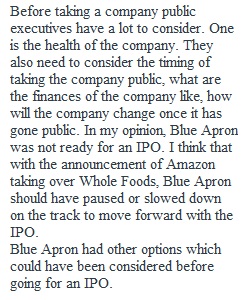


Q Read the following case study and answer the questions that follow. Respond to at least two of your peers with meaningful content. Blue Apron IPO Leaves a Bad Taste Founded in 2012, Blue Apron is one of the top meal-kit delivery services doing business in the United States. Started by three co-founders—Matt Salzberg, Matt Wadiak, and Ilia Pappas—Blue Apron provides pre-portioned ingredients (and recipes) for a meal, delivered to consumers’ front doors. According to recent research, the U.S. meal-kit delivery industry is an $800 million business with the potential to scale up quickly, as more and more consumers struggle to find time to go grocery shopping, make meals, and spend time with family and friends in their hectic daily lives. As word spread among foodies about the quality and innovative meals put together by Blue Apron, the company’s popularity took off, supported by millions in start-up funding. Costs to scale the business have not been cheap—estimates suggest that Blue Apron’s marketing costs have been high. Despite the challenges, by early 2017 the company was selling more than 8 million meal kits a month and decided to go public in an effort to raise more money and scale its operations, including a new fulfillment facility in New Jersey. According to the IPO paperwork filed with the SEC, the company had net revenues of $84 million in 2014, which increased to $795 million in 2016. However, those ambitious numbers were not without warnings: company losses increased in the same time period from $33 million to $55 million. Even with those larges losses on its balance sheet, Blue Apron decided to go ahead with the IPO and hired Goldman Sachs and Morgan Stanley, two top stock underwriters, to figure out the right price for the initial offering. While Blue Apron and its underwriters were finalizing stock prices, Amazon announced plans to acquire Whole Foods—a move that could negatively affect Blue Apron’s business going forward. Even after Amazon’s announcement, Blue Apron and its financial advisors priced the initial offering at $15 to $17 a share and met with investors across the country to inform them about the IPO, which would value the company on paper at more than $3 billion. As part of the IPO strategy, Blue Apron executives needed to communicate a strong financial picture while providing potential investors with an honest assessment of investor demand, especially for institutional investors, who typically are repeat buyers when it comes to IPOs. According to sources close to the IPO experience, Blue Apron’s bankers told investors late in the IPO pricing process that they were “closing their order books early,” which meant there was a heightened demand for the stock—a signal that the stock would be priced in the original $15–$17 range. A day later, however, Blue Apron amended its prospectus with a price range between $10 and $11 a share, which shocked potential investors—a move greeted with criticism that Blue Apron’s messaging now lacked credibility in the eyes of the investment community if the company priced the IPO $5 lower per share than originally estimated. With that sudden change in the IPO offering, investors walked away, and the $10 initial offering for Blue Apron stock actually declined on its first day of trading. As of this writing, the stock has lost close to 40 percent from the original $10-per-share price. With continued consolidation in the meal-kit delivery sector inevitable, Blue Apron is at a crossroads when it comes to generating revenue and stabilizing costs while trying to sign up more subscribers. One of its competitors, Plated, was recently acquired by the Alberstons grocery chain, and Amazon has already trademarked the phrase, “We do the prep. You be the chef,” as it relates to prepared food kits. Critical Thinking Questions 1. What issues should executives of a company such as Blue Apron consider before deciding to go public? In your opinion, was the company ready for an IPO? Why or why not? 2. How else could Blue Apron have raised funds to continue to grow? Compare the risks of raising private funding to going public. 3. Use a search engine and a site such as Yahoo! Finance to learn about Blue Apron’s current Prepare a brief summary, including the company’s current financial situation. Is it still a public company, and how has its stock fared? Would you invest in it? Explain your reasoning.
View Related Questions